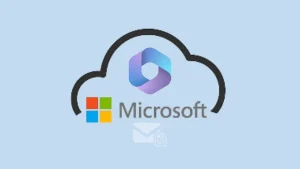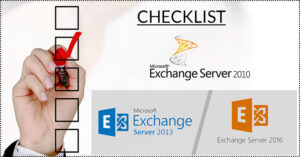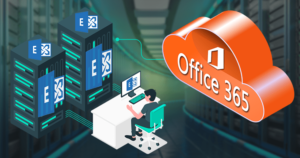Exchange Deployment is the process that allows users to set up and configure their Exchange Server to manage their contacts, emails, and other data. Whether users set up their Exchange from scratch or move from an older Exchange to a newer version, the Microsoft Exchange Deployment Assistant Tool simplifies these tasks effectively. However, users must adequately understand the Microsoft Assistant tool before using it to perform their deployment tasks without any issues.
Each user’s migration process might differ depending on their server’s environment, including Hybrid, On-Premises, or Exchange Online. So, users should read this blog to the end to gain intensive knowledge on the Exchange deployment assistant tool and how to use it.
Let’s know what is an Exchange Deployment Assistant Tool?
Exchange Deployment Assistant is a web-based solution that Microsoft offers to guide users through the deployment process according to their environment requirements. This free deployment assistant solution allows users to quickly deploy simple On-premises Exchange Servers as well as complex hybrid servers. This tool simplifies everything for the users, even if they are deploying Exchange Server for the first time.
Moreover, it also helps users generate a customized deployment checklist based on their answers to a series of questions. Users also have numerous benefits from using the Exchange deployment assistant tool to perform the migration or deployment process, which we will discuss in the upcoming section.
Features of the Microsoft Deployment Assistant Software
Users will get a lot of benefits from using the Exchange deployment assistant tool to migrate from an older version to an updated one. Let us now explore a few common advantages of using the EDA (Exchange Deployment Assistant) guide.
- Simplify Deployment: It asks users straightforward questions. After answering the questions, it provides the specific steps required to perform your task. By using the Exchange deployment assistant tool, users will not face any confusing situations and eliminate the deployment complexity.
- Stepwise Assistance: It offers step-by-step instructions to set up or configure their hybrid and On-premises Exchange Servers. We know it might be tricky for users to deploy a hybrid environment, but this task can become easy as pie if you have an Exchange assistant tool. Users also do not need prior experience following the assistant tool guide to configure Exchange, as it offers straightforward steps.
- Regular Updates: Microsoft regularly updates the Exchange deployment assistant tool to meet users’ needs and provide them with best practices for completing their tasks quickly and effectively. Moreover, it also ensures that the users get the updated guide for the latest Exchange Server services.
- Speeding Up Deployment: As we know, this tool generates customized checklists, which saves a maximum amount of time and provides them with accurate instructions. Moreover, the instructions are reliable, and every user can quickly deploy their Exchange environment. Apart from this, it is free software that is easily accessible for implementing migration and deployment tasks accurately.
Users have more benefits of using the Exchange deployment assistant tool to configure and set up their Exchange Server. Now, we will understand a few scenarios in which users can use the Exchange Assistant software.
Deployment scenarios supported by Microsoft Assistant Tool
The exchange deployment assistant tool allows users to cover a variety of deployment scenarios. Users can understand a few of them by scrolling down to the points shared below.
- On-Premises Exchange Deployment: It also supports On-Premises Exchange deployment, whether you are moving from an older version to a new one or deploying a new On-Premises Exchange Server in their system. So, if you want to perform the On-Premises Exchange server deployment, the Exchange deployment assistant tool is the best and quickest solution.
- Hybrid Exchange Deployment: Sometimes, users need to integrate their On-premises Exchange Server into Exchange Online in Office 365, which we generally call Hybrid Deployment. This tool ideally assists users whether their hybrid deployment is simple or a bit tricky.
- Cloud-based Deployment: Users can also perform cloud-based deployment using the Exchange deployment assistant tool. That means users can easily host all their services, like email, collaboration, etc., in the cloud using Exchange Online.
Here, we learned a few common deployment scenarios that Exchange deployment software allows. This tool also supports more scenarios for performing the deployment task to configure or migrate the Exchange Server.
How can users use EDA software to deploy an Exchange server?
To configure the Exchange Server, users do not need to download and install the Exchange Deployment Assistant Tool. Users can follow the instructions shared below to learn how to use this assistant tool.
Step 1: Go to Microsoft’s Exchange deployment assistant tool page and click the Launch the Deployment Assistant button.
Step 2: After launching the tool, you need to choose your deployment scenario, such as On-premises, Hybrid, Exchange Online, etc. Select the deployment scenario based on your environment and goal.
Step 3: Now, it will ask a few questions about your current environment and the deployment you are looking to perform. Please answer the questions carefully to get an accurate deployment checklist.
Step 4: After that, the tool will provide detailed step-by-step instructions on completing the deployment task. The generated checklist includes the following:
- Tasks before deployment, such as checking device requirements, etc.
- Instructions to configure the Exchange Server.
- Steps to integrate the cloud or hybrid deployments.
- Post-deployment tasks and resolving issues.
Step 5: Download the generated deployment checklist and follow each step carefully to deploy the Exchange Server smoothly.
After completing these steps, the Exchange deployment assistant tool guides you through the post-deployment instructions and verifications. Follow them and verify everything works properly, including mail flow, user access, etc.
Limitations of using the Exchange deployment solution
While the deployment tool has a few benefits, there are also some common limitations. Users must know its drawbacks to avoid unforeseen situations that can arise when they are deploying the Exchange Server using this tool.
- This web-based software may fail to deliver accurate instructions if the deployment is complex or requires a unique configuration.
- Users can’t automatically complete the deployment process using this tool, so they need to perform each step manually.
- Also, users will not receive technical support if they face any serious issues while performing the deployment.
- This tool doesn’t provide the proper guide to deploy the Exchange Server if users use an older version. It is the best tool for newer Exchange versions, including Exchange 2013, 2016, 2019, etc.
Users may face these limitations while working with the Exchange Deployment assistant software. Therefore, we advise users to use a professional third-party tool to migrate Exchange Servers or keep a backup of their essential data before implementing deployment tasks. It will help them protect their data from future unforeseen scenarios during deployment.
Why is choosing the Shoviv Exchange Migration Tool a good decision?
If users want a seamless transition from an older Exchange version to the latest one, they should choose the Shoviv Exchange Migration Tool. It allows users to perform the On-premises Exchange, Hybrid, and Exchange Online migration tasks. This software has no limitations on adding multiple mailboxes at once and their size. Moreover, users can also migrate their Exchange’s primary mailboxes, public folders, and archive mailboxes using this tool.
Users can easily monitor the real-time migration process, which the Exchange deployment assistant tool might fail to provide. It also has a scheduler feature to schedule the deployment tasks on a regular basis, including daily, weekly, monthly, or at any specific date and time. Moreover, users can filter their Exchange mailboxes’ items by date, item type, and folder-wise criteria. In addition, the folders’ hierarchy and data metaproperties will remain the same after performing the migration task.
Summing Up
The deployment process might be challenging to perform as users are transiting their crucial data from Microsoft Exchange. Therefore, a trustworthy solution is required to deploy the Exchange Server effectively. Moreover, users can also use the Exchange Deployment assistant tool to complete their migration process. However, this tool might have fewer limitations that can complicate and make the deployment risky. So, we advise users to have professional third-party software, like Shoviv Exchange Migration Tool, to migrate their Exchange data easily. Users can also try this software’s free demo version and freely process the first 50 items from each folder.
- How to Backup and Restore Emails in Webmail? - March 25, 2025
- How to Migrate Outlook to New Computer? - February 15, 2025
- Fix If Outlook Cannot Display the Specific Folder Location - February 1, 2025


